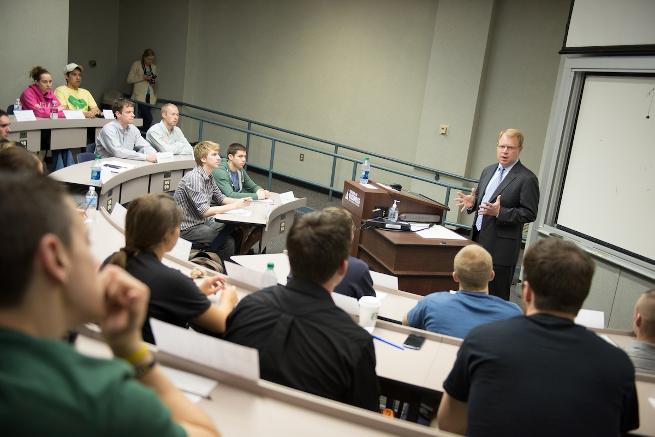HP executive returns to JMU to connect with students
Business
As a senior in the Computer Information Systems program in the College of Business in 1992, John Hinshaw was the first James Madison University student to bring a notebook computer to class. An internship with the American embassy in London the previous year had led to a consulting job, and Hinshaw kept in touch with his mates across the pond using the portable device, which was equipped with a 2,400-baud modem.
A lot has changed since then. Today’s computers can connect people around the world via the Internet in real time. JMU and the College of Business have risen to national prominence. And Hinshaw, currently executive vice president of technology and operations at Hewlett-Packard, is one of Silicon Valley’s most sought-after executives.
“Twenty-one years ago, I was sitting where you are,” Hinshaw told students in Dr. Thomas Dillon’s Enterprise Architecture class during a return visit to campus April 19 to share some of his experiences and lessons with future business leaders.
The CIS program at JMU “groomed me very well for the opportunities I’ve had,” Hinshaw said, adding, “The combination of the business degree and the CIS curriculum here is exactly what you need to be successful in the marketplace.”
Hinshaw’s climb on the corporate ladder has followed consumers’ appetite for newer, faster technologies. Following a stint with Accenture as a consultant, Hinshaw joined Bell Atlantic Corp. — later Verizon Corp. — and in 1997 was named senior vice president and chief information officer at Verizon Wireless, where he helped transform the company into a telecommunications giant.
“I thought I would retire with Verizon,” Hinshaw said, but in early 2007 a headhunter contacted him with a dream job opportunity. Boeing Co. in Chicago was looking for a new CIO to modernize its information architecture. Having grown up in Norfolk, Va., watching fighter jets and other planes manufactured by Boeing, “that was a company I could get excited about,” he said.
Among his many projects at Boeing, Hinshaw built the information architecture to support the 787 Dreamliner. “It’s a terrific plane,” he told students. “I hope you get to fly in it someday.” In 2009, Hinshaw was named CIO of the Year by the Executives’ Club of Chicago and named to Crain’s “40 Under 40” list. He then moved to Northern Virginia to lead Boeing’s new $3 billion Information Solutions unit, which sold security and IT solutions to clients including satellite providers and the federal government.
By late 2011, Hinshaw’s stock as an executive was sky-high, and Meg Whitman, president and CEO of Hewlett-Packard, tapped him to lead yet another corporate redesign. HP, already a global technology leader with $120 billion in annual sales and 330,000 employees in 170 countries, wanted to operate faster and stay on the leading edge of innovation. For Hinshaw, the position of executive vice president of technology and operations was the perfect fit for his education and experience. “I often believe you have to have the right person in the right job at the right time with the right attitude,” he said. “That’s what I look for when I hire people.”
These days Hinshaw is focused on cloud computing solutions and tackling the big three of information management challenges: mobility, security and big data. “The [micro]chips that are being developed today that sit in your smartphones and tablets are equivalent to some of the technology that was used to run the entire university computer system when I was a student here,” he said.
HP recently launched its Moonshot system, the first significant change in computer architecture since the development of the x86 server in 1989. Moonshot is a new generation of software-based web servers that run on 90 percent less computing power, in a smaller space, at less than half the cost of traditional mainframes. “Right now I’m running all of HP.com on the equivalent of 12 60-watt light bulbs,” he said.
Hinshaw took questions from CIS students on a range of topics, from advice on when to make a career move to effective leadership to the future of IT. He also toured the campus and had lunch with the JMU Honors Program Executive Advisory Council.
“Being back here reminds me of how well JMU and the College of Business prepared me for the challenges in my career,” he said. “I was energized talking with the students. I wish I could do it more often, and I will do it more often. It’s neat to get their ideas and what they’re thinking about.”
###
By Jim Heffernan (’96), JMU Public Affairs
